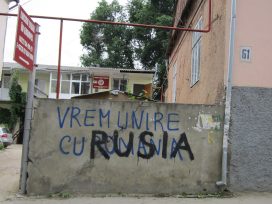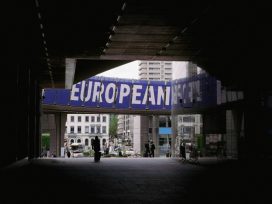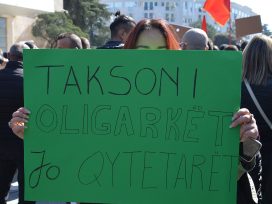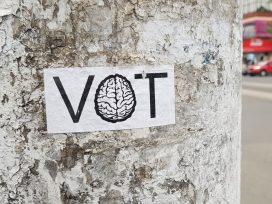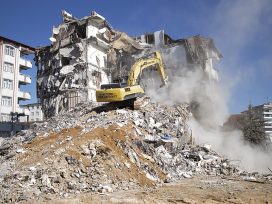Last year Slovenian civil society finally woke up from a deep sleep which had lasted since the early 1990s, when it presumed that by gaining its independence, Slovenia’s social and political struggle was over. It raised its voice against the collapse of the welfare state and the rule of law as well as against the widespread corruption in Slovenian politics and the economy. It demanded participation in political and c processes, while the more radical voices appealed for a change of the political and economic system. Many of these problems and anomalies in the society, politics and economy are similar to the major issues of the 1980s. For some of the protagonists of the cultural, social and political life of that time this is déjà vu. As early as at the beginning of the 1980s, some people were aware that Yugoslavia would not survive the pressure of the stabilisation measures (today they would be called austerity measures) and ethnic tensions at that time. To them it was only a question of when the country would break up. In 1983, an obituary for the Socialist Federal Republic of Yugoslavia (SFRJ) was published by the student magazine Tribuna (Vol. 33, No. 4) on its front and back page. The JBTZ trial in 1988 was merely an epilogue of the story of Yugoslavia’s disintegration, and not its introduction, as has been falsely claimed since the 1990s in the media and the increasingly pro-fascist political right. Today we are very much aware that the global capitalist system of irresponsible exploitation of natural resources, animals and people as well as of human slavery on the basis of (mostly virtual) debt cannot and must not continue. It is only a question of time as to when a shift (most likely a very violent one) will happen.
The 1980s in Slovenia have been presented as a turbulent decade of social, political and economic changes and alternative artistic practices. However, the event descriptions and interpretations in the political, social and cultural sense are focused mainly on Ljubljana, the capital city. This special issue of the Dialogi journal is dedicated to the creative practices and art venues of the 1980s in Maribor, the second largest Slovenian city. The idea of a special issue was born at the beginning of my research for and preparation of the exhibition dedicated to the alternative visual practices of this period, which is held at the Maribor Art Gallery. After the arrival of post-modernism it is hard to separate fine arts or visual practices from the influences or direct interventions of theatre, music, literature and film art in the production of art events, installations, interventions in the public arena and performances. Moreover, until now, the artistic, sub-cultural and social practices of this era in Maribor have not been analysed comprehensively or assembled in one location. To “bite the bullet”, a phrase used by several interviewed individuals when referring to this research, meant to reactivate the compiled heritage of alternative visual practices in the context of today’s social dissent and the importance of non-profit and alternative creative production for the city’s cultural and urban development. Many of Maribor’s problems and issues that occurred in the 1980s are still present. Rather than being resolved, they were pushed aside and forgotten in the euphoria after Slovenia had gained its independence. The difficulties that autonomous non-governmental cultural production faces today are no less acute than in the past, but the local authorities and mainstream media still ignore the various cultural and social alternatives. In the past, alternative creative practices were ideologically problematic for political oligarchs, whereas today they are not of interest simply because they are not profitable. The lack of funding of cultural institutions and their obsolete infrastructure, particularly that of the galleries, museums and non-governmental organisations, prove that Maribor does not have a vision for its development as a twenty-first century post-industrial city. Moreover, in the race to score political points both government/municipal and non-governmental institutions are portrayed as spendthrift and ineffective parasites feeding on the state budget. Their non-material and lasting influence on the community and the city is purposefully ignored, even though these institutions provide (free) access to cultural goods, education, critical thinking and possibilities of creative personal development of individuals of all ages and thus of the entire society.
The compiled texts have shown that in Maribor and its surroundings very interesting alternative creative practices, some more radical than others, developed in arts. They were all highly significant for the further development of the city’s culture in the 1990s. The special issue begins with an interview with Meta Gabersek Prosenc, a former head of the Rotovz Exhibition Salon and director of the Maribor Art Gallery. The interview was prepared by the current gallery director, Breda Kolar Sluga. The focus of the discussion was the significance and scope of the Ecology and Art triennial, which upon its establishment in 1980 had political support, and which with its contents and form introduced a high number of novelties in the local visual art and curating practices. However, the triennial soon proved to be politically incorrect, and even though subsequently seven triennials were held successfully and resonated both in Slovenia and abroad, the event did not qualify among the regularly financed art events in Maribor. The writer Tone Partljic describes the cultural and social atmosphere in Maribor through the eyes of a quintet of writer friends (Andrej Brvar, France Forstneric, Drago Jancar, Marijan Kramberger, Tone Partljic), and discusses the programme and management crisis of the Slovenian National Theatre Maribor. He touches on the role of the city in the breakup of Yugoslavia, when writing about the congress of the Writers’ Association of Yugoslavia in 1986 in Maribor that raised a lot of attention and influenced further Serbian hegemonistic and nationalistic endeavours. The dramaturge Vili Ravnjak presents “Dramski studio” (the Drama Studio) and the alternative theatre movement in Maribor. Dramski studio was an educational and artistic institution of Maribor high school and university students; it led to the establishment of the first two alternative theatre groups in Maribor in the late 1980s and early 1990s, and it encouraged the local youth to be more interested in theatre. According to Ravnjak, “the most prolific eras of theatre art are times when ‘a dictatorship transforms into democracy’, when theatres become an experimental space (laboratories) of the society, where ‘the limits of freedom are tested and pushed’. This is also one of the fundamental features of theatre of the 1980s.” The reaction to how closed and limited the Maribor cultural space was at the time was the decision of the Slovenian Youth Theatre (SMG) from Ljubljana to boycott the Slovenian theatre festival “Borstnikovo srecanje” in Maribor, and thus express its disagreement with the festival concept. Ivan Lorencic, the headmaster of the II Grammar School in Maribor, writes about the inventiveness of the school team and students who, in co-operation with the SMG company, made it possible for the Maribor audience to see the SMG’s annual repertoire in the course of the spring festival for five years in a row. The school was an alternative venue for performances not only of the SMG, but also of the experimental theatre Glej and theatre groups from abroad, Brane Roncel’s jazz evenings or the first concert of the Lacni Franz rock group in 1979. The initiative and innovativeness of the school’s management and students contributed to a cultural programme which was fresh and very different from the other, predominantly conservative events in the city. The geodesist and civil society activist Joze Kos Grabar, Jr. has contributed a concise presentation of what he conditionally calls “the alternative scene”. To him this means “a collection of various youth, innovative and/or (sub)urban cultures and subcultures that were publicly present and in various ways socially more radically active in Maribor and its surroundings”. He presents the alternative creative practices in music, visual art and literature as well as the alternative activities in publishing, media landscape and socio-political engagement. The cultural anthropologist Rajko Mursic describes the “alternative scene” of Maribor and the region by focusing on major protagonists, musicians and music groups. He emphasizes the role of creative production and co-operation of individuals and groups with similar interests in increasing the urban heartbeat of the city. In the author’s opinion, residential estates and clusters of buildings alone do not make a city. “Where it appears to be a city, Maribor is actually a village. […] However, where nobody can see the city, in its underground or on its edge, in its most marginal points, the true urban culture is nurtured.” In the final article of this special issue of the Dialogi, the curator Meta Kordis summarizes the visual alternative practices of local artists that were presented at the exhibition Mi, vi, oni (Us, You, Them). Fragments of the 1980s Alternative Practices in Maribor (5 November 2013 – 9 February 2014) at the Maribor Art Gallery. These practices all rely on the use of new technologies, copying (xerox), fragmented artistic expression and its spatial expansion in the form of installations or performances. These are elements of postmodernist explorations and are a part of alternative creative production. Certain authors are featured several times – as designers, painters, musicians, initiators, writers, photographers, video artists and performers.
In this issue of Dialogi, we initially aimed at presenting the widest possible spectrum of creative practices and venues. Unfortunately, as we depend on the human factor, we will not be able to read about what happened in the “Kino gledalisce” cinema in the 1980s, where European art films were screened (the cinema was a kind of a predecessor of today’s city cinema Udarnik). Nor we will read about the role of the student newspaper Katedra, or how the First Grammar School with its exhibition venue Avla and the student theatre (e.g. Tomaz Pandur’s “Tespisov voz” company) contributed to a livelier cultural life in Maribor, which also opened new possibilities and venues for creative production; and finally, we will not read the literary analysis of the fanzine production (prose and poetry).
I sincerely hope that both, the Us, You, Them exhibition and this publication, will at least partially fill the gap in the hidden and forgotten past in order to reopen and continue the dialogue on the vision of the city of Maribor’s development, which began in the 1980s.
Let me conclude with the insightful words of Rajko Mursic: “In the town which used to boast successful industrialization and is still struggling with the de-industrialisation nobody should be silent. In this city a noise should be heard constantly, not only during protests when people have really had enough of it all. It is precisely in this that I see the essence of what links the 1980s and the 2010s: the same crisis, the same stabilisation, the same unemployment, the same desperation and the same silence of those who should be making a noise. On the other hand, there is this exceptional stubbornness of a few individuals whom nobody takes seriously.”
